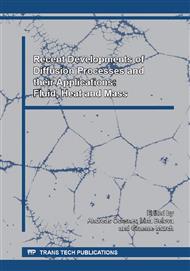p.9
p.18
p.27
p.35
p.44
p.61
p.71
p.80
p.92
Microgeometry Modelling of Magnesium Alloy Polished Surfaces by Means of Cone-Based Manifolds
Abstract:
In this paper a new methology for surface microgeometry modelling is presented, taking the surface of a polished magnesium alloy as an example . The proposed method essentially is based on the usage of the mathematical concept of the continuous non-differentiable manifold composed of cones. The cones’ aperture, eccentricity, height and angular orientation are model parameters, as well as the cones spread over the modelled surface. The spread of cones might be of very different nature ranging from simple deterministic patterns to purely random distribution accordingly to the theory of spatial point processes. The statistical parameters estimated in the model are: Rp, Rv, Rt, Ra, Rq, Rskew, Rkurt, the roughness distribution histogram and the bearing curve. The geometrical parameters are: surface area, surface development, surface capacity and volume. All of the computational methods have been carefully examined from the perspective of use on discrete grids. The simulated surfaces have been compared with experimental results obtained with the used AFM technique on samples of the polished AZ31 magnesium alloy. The very high level of conformity achieved between the results from the modeled surface and the experimentally obtained results gives us a promising prognosis for further use.
Info:
Periodical:
Pages:
44-60
Citation:
Online since:
June 2015
Authors:
Price:
Сopyright:
© 2015 Trans Tech Publications Ltd. All Rights Reserved
Share:
Citation:


